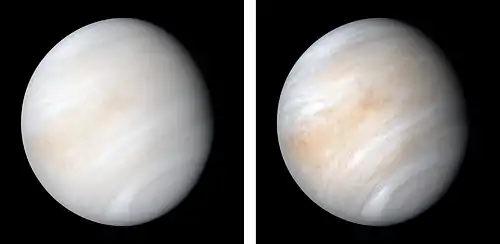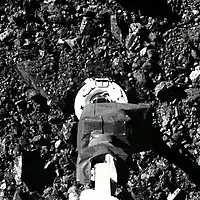2020 VT1
2020 VT1 is a small asteroid, classified as a near-Earth object of the Amor group, that is a temporary horseshoe companion to Mars.[6]
| Discovery | |
|---|---|
| Discovered by | Pan-STARRS |
| Discovery site | Haleakalā Observatory |
| Discovery date | 10 November 2020 |
| Designations | |
Designation | 2020 VT1 |
| Orbital characteristics[2][3][4] | |
| Epoch 31 May 2020 (JD 2459000.5) | |
| Uncertainty parameter 6 | |
| Observation arc | 5 days |
| Aphelion | 1.7774 AU |
| Perihelion | 1.26868 AU |
| 1.5231 AU | |
| Eccentricity | 0.167021 |
| 1.88 y (686.6 d) | |
| 315.410° | |
| Inclination | 18.717° |
| 50.169° | |
| 296.191° | |
| Earth MOID | 0.350402 AU |
| Physical characteristics | |
| Dimensions | 50–150 m[a][5] |
| 22.9[2] | |
Discovery
2020 VT1 was discovered on 10 November 2020 by J. Bulger, K. Chambers, T. Lowe, A. Schultz, and M. Willman observing for the Pan-STARRS Survey.[7] As of 20 January 2021, it has been observed 28 times with an observation arc of 24 days.[2]
Orbit and orbital evolution
2020 VT1 is currently an Amor asteroid. Its semi-major axis (currently 1.5231 AU) is similar to that of Mars (1.52380 AU), but it has a low value of orbital eccentricity (0.16702) and moderate orbital inclination (18.717°).[6]
See also
References
- List Of Amor Minor Planets
- 2020 VT1 at the JPL Small-Body Database
- Close approach · Discovery · Ephemeris · Orbit diagram · Orbital elements · Physical parameters Retrieved 2021-01-20
- AstDys-2 on 2015 YA Retrieved 2021-01-20
- NEODyS-2 on 2015 YA Retrieved 2021-01-20
- Absolute-magnitude conversion table (H)
- de la Fuente Marcos, Carlos; de la Fuente Marcos, Raúl (March 2021). "Using Mars co-orbitals to estimate the importance of rotation-induced YORP break-up events in Earth co-orbital space". Monthly Notices of the Royal Astronomical Society. 501 (4): 6007–6025. arXiv:2101.02563. Bibcode:2021MNRAS.501.6007D. doi:10.1093/mnras/stab062.
- Discovery MPEC
- Further reading
- Understanding the Distribution of Near-Earth Asteroids Bottke, W. F., Jedicke, R., Morbidelli, A., Petit, J.-M., Gladman, B. 2000, Science, Vol. 288, Issue 5474, pp. 2190–2194.
- A Numerical Survey of Transient Co-orbitals of the Terrestrial Planets Christou, A. A. 2000, Icarus, Vol. 144, Issue 1, pp. 1–20.
- Debiased Orbital and Absolute Magnitude Distribution of the Near-Earth Objects Bottke, W. F., Morbidelli, A., Jedicke, R., Petit, J.-M., Levison, H. F., Michel, P., Metcalfe, T. S. 2002, Icarus, Vol. 156, Issue 2, pp. 399–433.
- Transient co-orbital asteroids Brasser, R., Innanen, K. A., Connors, M., Veillet, C., Wiegert, P., Mikkola, S., Chodas, P. W. 2004, Icarus, Vol. 171, Issue 1, pp. 102–109.
External links
- Discovery MPEC
- 2020 VT1 data at MPC
- 2020 VT1 at NeoDyS-2, Near Earth Objects—Dynamic Site
- Ephemeris · Obs prediction · Orbital info · MOID · Proper elements · Obs info · Close · Physical info · NEOCC
- 2020 VT1 at ESA–space situational awareness
- 2020 VT1 at the JPL Small-Body Database
This article is issued from Wikipedia. The text is licensed under Creative Commons - Attribution - Sharealike. Additional terms may apply for the media files.


_on_Jul_14_2020_aligned_to_stars.jpg.webp)